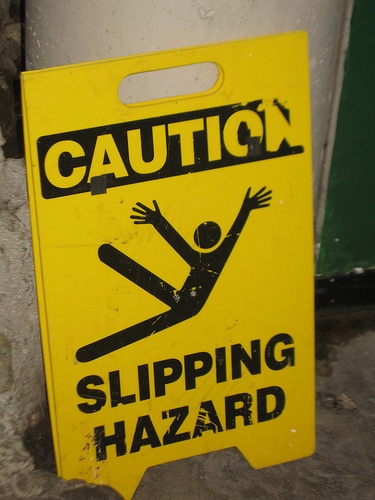The Occupational Safety and Health Administration (OSHA) requires most employers to prepare and maintain records of occupational injuries and illnesses (I&I Logs) as they occur. OSHA also requires employers to post an annual I&I Summary in each “establishment” within their workplace by February 1, summarizing that workplace’s I&Is during the previous calendar year. Delegated state-run programs impose comparable requirements.
Read MoreAudit, Compliance and Risk Blog
Tags: Employer Best Practices, Health & Safety, OSHA, Employee Rights, EHS
Every winter, employee and public health officials around the world prepare for influenza (“flu”) seasons, which vary from mild to the occasional pandemic. Here in the U.S., the Centers for Disease Control and Prevention (CDC) issue annual forecasts of the strain(s) expected to be dominant, the severity of resulting health impacts, and of the availability and efficacy of vaccinations.
Read MoreTags: Employer Best Practices, Health & Safety, OSHA, Employee Rights, California Legislation
Live Shooting Tragedy at WDBJ-TV: Why Reference Checking Matters
Posted by W. Barry Nixon on Mon, Dec 14, 2015
It’s exceedingly difficult to predict workplace violence, and there is no easy solution to stop it altogether, however, reference checking is a preventative step that employers can take to reduce the risk. I would add that, in my professional opinion, many workplace violence incidents could be prevented if employers took the necessary precautions before an incident actually unfolded.
Read MoreTags: Employer Best Practices, Health & Safety, Employee Rights, Workplace violence
OSHA Proposes to Revise Safety and Health Program Guidelines
Posted by Jon Elliott on Tue, Dec 08, 2015
In 1989 OSHA issued “Safety and Health Program Management Guidelines” (S&H Guidelines), recommending activities employers should undertake to ensure their employees’ safety and health. The S&H Program Guidelines encourage employers to institute and maintain an “effective occupational safety and health program.” Some state occupational safety and health regulators have used these (voluntary) guidelines as the basis for mandatory employer programs – including California’s Injury and Illness Prevention Program (IIPP) requirement and Washington’s Accident Prevention Program (APP) requirement. OSHA proposed a national rule in 2012, but after several delays has designated it a “long term action.”
Read MoreTags: Employer Best Practices, Health & Safety, OSHA, Employee Rights, EHS
The US Environmental Protection Agency (EPA) administers a Worker Protection Standard (WPS) designed to protect workers exposed to agricultural pesticides. WPS is patterned after the Occupational Safety and Health Administration (OSHA's) Hazard Communication Standard (HCS) for workers in most other industrial and commercial settings. EPA adopted the WPS in 1992, and just adopted its first revisions late in September 2015. Some of these changes incorporate revisions to HCS adopted by OSHA in 2012 (see here), while others catch up on two decades of industrial hygiene and worker safety practices. The revisions will appear in the Federal Register (probably in November) and become effective 60 days later. Compliance deadlines extend for up to 2 years for the various changes.
What Does WPS Require Now?I summarized longstanding WPS requirements when I blogged last year about EPA’s proposed revisions (click here ). To further summarize my summary, WPS requires employers whose employees work with or around pesticides to provide the following:
-
Pesticide safety training
-
Labeling information
-
Specific information including pesticide-specific training within 5 days after beginning work (“grace period”), supplementing immediate emergency information and a pesticide safety poster
-
Requirements to keep workers out of areas being treated with pesticides, within nurseries and greenhouses (“buffer”)
-
Requirements to keep workers out of areas during a restricted-entry interval (REI) set for each pesticide
-
Protect early-entry workers doing permitted tasks in pesticide-treated areas during an REI, including special instructions and personal protective equipment (PPE)
-
Required warning to nearby workers about pesticide-treated areas (oral and/or warning signs, depending on the chemical)
-
Monitor handlers using highly toxic pesticides, at least every 2 hours
-
Provide required PPE to handlers (e.g., clothing, respirators)
-
Provide decontamination supplies
-
Provide for emergency assistance.
Some requirements apply on behalf of all agricultural workers who may be exposed, plus additional requirements for pesticide handlers who work with regulated pesticides.
What Changes is EPA Adopting?
EPA has adopted a wide variety of revisions, including provisions that have changed significantly from last year’s proposal. Revisions include:
-
Training (compliance deadline delayed for 2 years):
Tags: Employer Best Practices, Health & Safety, Employee Rights, Environmental risks, Environmental, EPA
Your Employee Has A Drug Or Alcohol Problem—Now What?
Posted by STP Editorial Team on Tue, Nov 10, 2015
A manager reports to you that one of your workers, Joe, has admitted to a problem with alcohol. Or perhaps there’s an accident in the workplace and the ensuing investigation reveals that Jane is a regular drug user. Or John arrives at the office, once again unfit to do his job because he’s “under the influence.”
Read MoreTags: Employer Best Practices, Health & Safety, Employee Rights, Workplace violence, Canadian
Department of Justice Targets Individuals While Investigating Organizations
Posted by Jon Elliott on Tue, Oct 27, 2015
 When an organization breaks the law, the actual actions must be taken by individuals associated with the organization–whether it’s a rogue individual or a vast internal conspiracy. So who’s culpable and for what? Laws often provide civil liability for most violations and criminal liability for the most severe, and many include parallel provisions addressed both to organizations and individuals. Most enforcement agencies produce enforcement and prosecutorial guidelines for agency personnel to provide criteria that channel their “prosecutorial discretion.” Variations in such guidelines may tend to keep organizations and their personnel aligned – as when they’re all going to be prosecuted together anyway–or may encourage fissures between them – as when one can reduce its own liability by incriminating another.
When an organization breaks the law, the actual actions must be taken by individuals associated with the organization–whether it’s a rogue individual or a vast internal conspiracy. So who’s culpable and for what? Laws often provide civil liability for most violations and criminal liability for the most severe, and many include parallel provisions addressed both to organizations and individuals. Most enforcement agencies produce enforcement and prosecutorial guidelines for agency personnel to provide criteria that channel their “prosecutorial discretion.” Variations in such guidelines may tend to keep organizations and their personnel aligned – as when they’re all going to be prosecuted together anyway–or may encourage fissures between them – as when one can reduce its own liability by incriminating another.
The U.S. Department of Justice (DOJ) conducts most criminal prosecutions brought against violators of U.S. federal laws. DOJ’s U.S. Attorneys also provide legal support to many federal agencies in civil cases brought by the agencies for regulatory violations. To regularize these wide-ranging responsibilities, DOJ promulgates enforcement policies and priorities, which are compiled in the “U.S. Attorneys’ Manual.”
How Has DOJ Approached Individual Prosecutions For Organizational Wrongdoing?
DOJ has repeatedly adjusted its policies for prosecuting individuals in organizational wrongdoing cases. In 2003, DOJ issued an enforcement policy seeking to separate organizations from their agents – telling organizational defendants that indemnification of their officers (i.e., paying their defense costs under employment contracts and bylaws) would be interpreted as support for the individuals’ malfeasance, precluding DOJ from applying lenience to the organization for having “cooperate[d] in the investigation of its agents” (the “Thompson memorandum”). This policy was intended to prevent organizations from shielding their personnel, and so to encourage more individual prosecutions. However, this policy was rescinded after a 2006 court decision excoriated DOJ, holding that the policy violated individual defendants’ Constitutional rights by exerting undue pressure on organizations (U.S. v. Stein).
In 2006, DOJ softened the offending policy by reemphasizing that many criteria may apply to charging and prosecutorial decisions, and stating explicitly that an organization’s decision to follow state laws and establish indemnification provisions would not be considered a failure to cooperate sometime later with federal prosecutors (“the McNulty memorandum”; later enshrine in the U.S. Attorneys’ Manual section 9.28). Thus, DOJ policy for nearly a decade has not explicitly attempted to pit organizational defendants against their individual human agents – but also has not provided clear guidance to prosecutors in determining whether to proceed against organizational defendants, individual defendants, or both. During these years, the trend has been toward fewer prosecutions of individuals, even where it seems likely that top managers were integral participants in financial or regulatory violations. This lack of headline-grabbing prosecutions has produced a political backlash and pressure to re-balance prosecutorial policies.
How Does DOJ’s Newest Policy Favor Individual Prosecutions?
In September, Deputy Attorney General Yates issued DOJ’s latest enforcement policy memorandum, addressing “Individual Accountability for Corporate Wrongdoing.” DOJ will apply this latest revision to all criminal prosecutions, and to civil enforcement as appropriate. The memo sets forth 6 basic criteria for U.S. Attorneys to apply and follow:
- “To be eligible for anv cooperation credit, corporations must provide [DOJ] all relevant facts about the individuals involved in corporate misconduct.
- Both criminal and civil corporate investigations should focus on individuals from the inception of the investigation.
- Criminal and civil attorneys handling corporate investigations should be in routine communication with one another.
- Absent extraordinary circumstances, no corporate resolution will provide protection from criminal or civil liability for any individuals.
- Corporate cases should not be resolved without a clear plan to resolve related individual cases before the statute of limitations expires and declinations as to individuals in such cases must be memorialized.
- Civil attorneys should consistently focus on individuals as well as the company and evaluate whether to bring suit against an individual based on considerations beyond that individual's ability to pay.”
If organizations respond to these incentives by providing incriminating facts about individuals, the new policy will tend to create wedges between organizations and their personnel, which DOJ is now pledging to prosecute more vigorously. It remains to be seen how these incentives will actually be applied by prosecutors, followed by defendants, and reviewed by courts.
Self-Assessment Checklist
- Has the organization established compliance and/or ethics programs to prevent and detect violations of applicable laws?
- Do formal organizational policies define standards and procedures for agents and employees?
- Are specific high-level personnel assigned responsibility and authority to ensure these standards and procedures are followed?
- Does the organization provide training and/or other means to communicate standards and procedures effectively to its agents and employees?
- Is there an effective program for enforcing these standards (e.g., monitoring and audits)?
- Are there internal reporting mechanisms (including protections against possible retaliation)?
- Does the program include clear and effective disciplinary mechanisms?
- Does the program provide for immediate and appropriate steps to correct the condition giving rise to any detected offense or violation (e.g., program changes and individual disciplinary actions)?
- Does the program include provisions for self-reporting to appropriate authorities?
Tags: Corporate Governance, Employer Best Practices, Employee Rights
Safety Programs Are Essential For The Automotive Workplace
Posted by STP Editorial Team on Tue, Sep 29, 2015
“No one should have to sacrifice their life for their livelihood, because a nation built on the dignity of work must provide safe working conditions for its people.”
– Secretary of Labor, Thomas E. Perez
Tags: Employer Best Practices, Health & Safety, OSHA, Employee Rights, California Legislation, Environmental risks, Environmental, Transportation
Meeting OSHA Requirements On Employee Exposure And Medical Records
Posted by Jon Elliott on Tue, Sep 22, 2015
A wide variety of Occupational Safety and Health Administration (OSHA) standards require employers to acquire or create documentation of employees’ exposures to potentially hazardous materials and contaminants in their workplaces, and to inform employees of the presence of these hazards. For example, the Hazard Communication Standard (Hazcom) requires most employers to acquire Safety Data Sheets (SDSs) and provide workplace labeling and employee training. Other standards require employers to monitor their workplaces for airborne exposures to contaminants, and to compare such exposures to permissible exposure limits (PELs) or action levels. Some standards require employers to conduct medical monitoring of employees who are subject to such exposures. These records can be vitally important to provide information on long-term (chronic) health effects of exposures.
Tags: Employer Best Practices, Health & Safety, OSHA, Employee Rights, EHS, Hazcom
Although Environmental Health and Safety (EH&S) requirements target hundreds of micro-organisms (primarily viruses and bacteria), regulation of important hazards remain on the drawing boards, awaiting appropriate testing and control methodologies, sufficient resources … and high enough political priorities. Until recently, one of these unregulated pathogens has been the legionella bacterium, first identified in 1976 as the cause of “Legionnaire’s disease” – named after an outbreak at an American Legion convention in Philadelphia traced to the hotel’s air conditioning system. This summer, however, an outbreak in New York has led state and local health agencies to adopt extremely ambitious testing and disinfection programs.
Tags: Employer Best Practices, Health & Safety, Employee Rights, Environmental risks, Environmental, EHS, EPA









